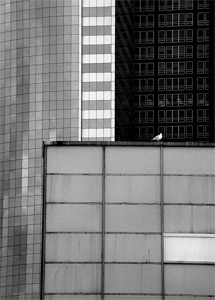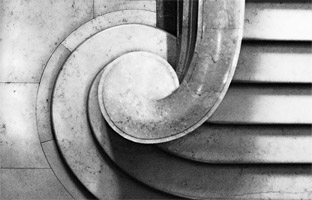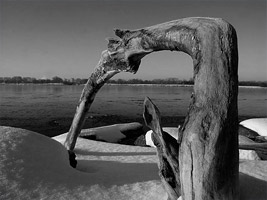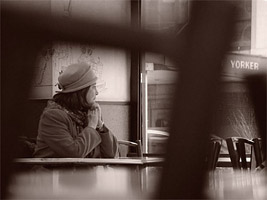Black & White Photography
On this page I will try to express my feelings and thoughts after reading series of "Better Picture Guide to..." and my own experiences:
- Seeing in Black & White
- Light & Form
- Exploiting Texture
- Using Shapes and Forms
- The Art of Selection
- Choosing a Viewpoint
- Framing the Image
- Attract the Eye
- Creating Mood
Seeing in Black & White

Black and white photographs make you perceive the world without colors and notice and appreciate forms, textures, shapes and tones. The contrast colors (i.e. reds and blues) will not always produce a contrast of tones. There is another part of the colors, which is their tones. I consider tones as an intensity of light reflected by objects. And the black and white photograph is completely based on the tones, it won't record any colors. As an example, mid-tone red and blues will be captured as mid-tone grays and without a big difference. That's why if the scene has many colors but with similar intensity of light it will be recorded as a flat and lifeless photograph. On the other hand too much contrast in tones and it will be a harsh and very dramatic image. There is one technique that is used by many photographers: to look at the scene through half-closed eyes to judge the contrast. Another way is to use brown or green filter and use it as tool to estimate contrast of the scene. Read the article "Converting into Black and White" to find out how you can create a black and white photograph from a color one in Photoshop. Or if a simple technique is not fo you, learn to Control Tone and Contrast in BW Conversion.
~ Top ~Light & Form

How our mind defines a three dimensional form of a subject on a flat two dimensional image? The answer is obvious - the shadows and highlights. By the distribution and intensity of the tones our mind defines the form and depth. That's why the quality of light plays a key role in black and white photography. And when there are no colors to distract our eye the subtleties of tones are so noticeable. To control the impression , which is acquired by the viewer's mind you have to pay attention how the subject is lit, where and how the shadows fall, the sharpness of their edges, the density of the shadows. Learning to see the light anew will help you to use different lighting effects for your own needs (i.e. to create mood, to focus attention).

Exploiting Texture
Often you will use texture to convey specific impressions. And again, without distracting colors the impact will be much stronger. The texture is a pattern of forms within a form. And as any form it requires some highlights and shadows to be properly and powerfully conveyed. So be aware of the direction and the quality of the light in terms of the texture, not only the whole form of the subject. There is one aspect that should be considered for creating a strong impression of texture - sharpness of the image, so a tripod and a depth of field will help you to obtain it.
~ Top ~Using Shapes and Forms

Viewing a black and white photograph as a graphical image help us recognize lines, shapes, shadows and forms. Lines define the shape of the object and identify it, shadows create a form and define its depth and three dimensional feeling. Sometimes it is just a shape, which gives the strong impression to the image. So don't hesitate and explore this side of the image graphics. However there is one aspect you have to keep ?n mind, a good tonal contrast between the subject and its background will help you ensure prominence of the subject. The lines, shapes and forms in design of a photograph have its own meaning which is covered in the article Graphics In Photography
~ Top ~The Art of Selection

To produce a good photographs you have to see the subject. It means that by looking at a subject you have to see the full potential of the subject, which can be expressed in the photograph. Next thing to consider is what to include in the frame. Painting is art of inclusion, photography is art of exclusion. One of the simplest ways to make a good photographs is to get a close-up of the subject, i.e. include as much of the subject as possible, leaving everything out of the frame. There is an example, one photographer has taken a single eye of a new elephant delivered to a zoo, when others took the whole animal. And his photograph was selected for a magazine cover.
In cases with close-ups I find it appealing to include some small part of the environment where the subject resides. It is a good corner stone for further thinking about the photograph.
~ Top ~Choosing a Viewpoint

The subject in the photograph is viewed from a certain position and this position or point of view is very important for impact the photograph will convey. That's why even before taking a picture observe the subject from different points of view, so you can select the best background for the subject and highlight some traits of the subject (i.e. simple and "comfortable" background, lines of the shape, silhouetting it against the sky, etc.). The subject is not alone in the picture, most probably you are trying to convey some association betwen the subject with the other objects or people in the frame. So make sure that the associations are easily traceable. You may even need a visual path or two to create support the associations. When you are taking pictures of kids or pets/animals consider lowering the camera to their eye level, it will make them more important in the frame and attract more attention.
~ Top ~Framing the Image

You probably already know about the rule of thirds, when the image should be framed so that the main point of interest is placed where lines dividing the image in thirds intersect with each other. But actually the rule is based on ancient observation regarding appealing view of forms and lines - the golden mean. The golden mean can be described in the following way: a position of point C on a segment A-B results into equivalence of the proportion of the smallest segment (AC) to bigger segment (CB) is equal to the proportion of the bigger segment (CB) to the whole segment (AB). The length of the bigger segment will be about 0.6666 of the whole segment. Bored and lost? Me too, so simply consider moving the subject from the center of the photograph.
Well, so the ancestors said that such a placement is appealing for the eye, but it doesn't always creates a perfect photograph. You have to consider an overall balance of the picture before deciding on the way it is framed.
There is almost a "rule" for inexperienced photographers - to put the subject in the dead center of the frame. It looks like the shoot from a gun :) The dead center position may be a good approach for some photographs, but it is rare, so better if you first consider other variants. Moreover, the dead center position makes you forget about what is around and it results in cluttering the frame with unwanted details. Read more on Composing the Frame.
~ Top ~Attract the Eye

Almost always our eye is drawn to the most contrast area in the frame. That's why before taking the picture look at the scene within the frame and find most contrast areas. Consider how the areas relate to the subject: do they attract attention to the subject or distract from it? Sometimes it is a good approach to use those areas at the border of the subject (i.e. silhouettes). But beware when these areas (like a window) are behind or too close to the subject, it definitely distract the eye from the subject and make some problems with exposure control.
~ Top ~Creating Mood

Mood is an elusive element in a photograph. It's something which can
often be present in a situation but is very difficult to convey on
film (or on a sensor). You can try to express it with colors within the frame but in
black and white photography you have to find another way. And the
way is tonal range and contrast of the image. The best approach to
convey mood in the picture is leave just a hint of it, so the viewer
can imagine it by himself. Don't show everything to the viewer, let
him think and imagine. It could be achieved by removing details from
shadows and/or highlights (depends on the key of the image). ![End of the article [end of the text]](http://www.romanzolin.com/img/misc/text_end.png)





